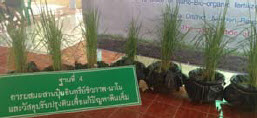Promotion of Community Participation for Saline Soil Remediation by Alternative Technology of Bio-Organic Fertilizers and Nano Material at Krabueang Yai, Phimai District, Nakhon Ratchasima Province
Keywords:
Community participation, Saline soil, Alternative technology, Bio-organic fertilizers, NanomaterialAbstract
This paper is applied research to create changes in the community. The objectives of this research were the study of the bio-organic fertilizer production process in Ban-Toey Community Enterprise at Krabueang Yai, Phimai District, Nakhon Ratchasima Province and promoting the community participation in the remediation of saline soil by the alternative technology such as bio-organic fertilizers and nanomaterial. The research methodology of this study was carried out by studying the data sources and information from the community and on-site events or activities Moreover, in-depth interviews, group discussions, observation, questionnaires demonstrations were also carried out in order to transfer knowledge from the laboratory outcome to the community. The result was found that promotion of community participation for saline soil remediation by alternative technology of bioorganic fertilizers and nanomaterials at Krabueang Yai were operated by share and learn activities, in-depth interviews, group discussion, observation and questionnaires. The demonstrations were also carried out in order to transfer knowledge from the laboratory outcome to the community. After the activities, it was found that the community changes including a deep understanding of the saline soil solutions, production of bio-organic fertilizer, nanotechnology and soil tests. Moreover, Ban-Toey villagers planned to establish soil quality analysis services during the soil adjustment of the field and agricultural area. A cooperative creating was to resolve saline soil problems. In addition, the view of the participants should be changed that nanomaterial could be nonexpensive. Participants who were more liberal on new ideas such as nanotechnology can be the better starting point for the solving of saline soil problems and alternatively helping the community to increase agricultural productivity and benefits.
References
Department of Land Development. (2013). Salty tolerant plants and salt-like plants. [Online]. Department of Land Development. Retrieved
from http: www. Idd.go.th. (25 August 2013).
El-Shall, M. S., Graiver, D., Pernisz, U., & Baraton, M. I. (1995). Synthesis and characterization of nanoscale zinc oxide particles: I. laser
vaporization / condensation technique. Nanostructured Materials, 6, 297-300.
Jiamjitrpanich, W., Parkpian, P., Polprasert, C., & Kosanlavit, R. (2012). Enhanced phytoremediation efficiency of TNTcontaminated soil by nanoscale zero valent iron. International Proceedings of Chemical, Biological and Environmental Engineering, 35, 82-86.
Jiamjitrpanich, W., Parkpian, P., Polprasert, C., & Kosanlavit, R. (2013). Trinitrotoluene and its metabolites in shoots and roots of Panicum
maximum in nanophytoremediation. International Journal of Environmental Science and Development, 4(1), 7-10.
Jiamjitrpanich, W., Parkpian, P., Polprasert, C., Laurent, F., & Kosanlavit, R. (2012). The tolerance efficiency of Panicum maximum and Helianthus annuus in TNTcontaminated soil and nZVI-contaminated soil. Journal of Environmental Science and Health, Part A: Toxic / Hazardous Substances and Environmental Engineering, 47(11), 1506-1513.
Jiamjitrpanich, W., Polprasert, C., Parkpian, P, Delaune, R. D., & Jugsujinda, A. (2010). Environmental factors influencing remediation of TNT-contaminated water and soil with nanoscale zero valent iron particles. Journal of Environmental Science and Health, Part A: Toxic / Hazardous
Substances and Environmental Engineering, 45(3), 263-274. doi:10.1080/10934520903468012
Masciangioli, T. & Zhang, W.-X. (2003). Environmental technologies at the Nanoscale. Environmental Science & Technology, 37(5), 102-108. doi:
1021/es0323998













